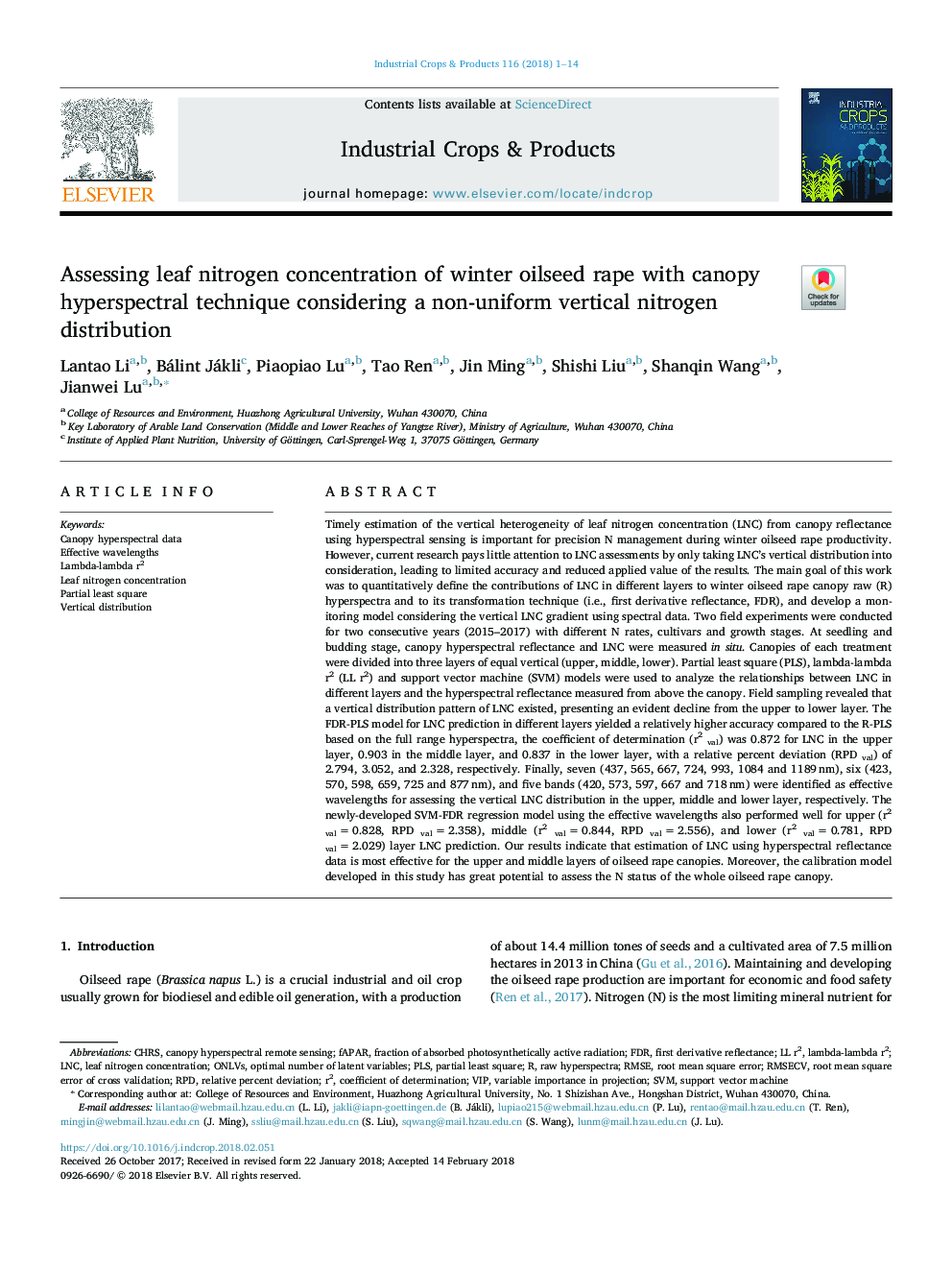| کد مقاله | کد نشریه | سال انتشار | مقاله انگلیسی | نسخه تمام متن |
|---|---|---|---|---|
| 8880266 | 1624794 | 2018 | 14 صفحه PDF | دانلود رایگان |
عنوان انگلیسی مقاله ISI
Assessing leaf nitrogen concentration of winter oilseed rape with canopy hyperspectral technique considering a non-uniform vertical nitrogen distribution
دانلود مقاله + سفارش ترجمه
دانلود مقاله ISI انگلیسی
رایگان برای ایرانیان
کلمات کلیدی
PLSChrsLNCVIPRPDfAPARFDRRMSECVRMSEvariable importance in projection - اهمیت متغیر در طرحVertical distribution - توزیع عمودیpartial least square - حداقل مربعات جزئیRoot mean square error - ریشه میانگین خطای مربعRoot mean square error of cross validation - ریشه میانگین خطای مربع اعتبارسنج متقابل استcoefficient of determination - ضریب تعیینLeaf nitrogen concentration - غلظت نیتروژن برگSVM - ماشین بردار پشتیبانیSupport vector machine - ماشین بردار پشتیبانی
موضوعات مرتبط
علوم زیستی و بیوفناوری
علوم کشاورزی و بیولوژیک
علوم زراعت و اصلاح نباتات
پیش نمایش صفحه اول مقاله

چکیده انگلیسی
Timely estimation of the vertical heterogeneity of leaf nitrogen concentration (LNC) from canopy reflectance using hyperspectral sensing is important for precision N management during winter oilseed rape productivity. However, current research pays little attention to LNC assessments by only taking LNC's vertical distribution into consideration, leading to limited accuracy and reduced applied value of the results. The main goal of this work was to quantitatively define the contributions of LNC in different layers to winter oilseed rape canopy raw (R) hyperspectra and to its transformation technique (i.e., first derivative reflectance, FDR), and develop a monitoring model considering the vertical LNC gradient using spectral data. Two field experiments were conducted for two consecutive years (2015-2017) with different N rates, cultivars and growth stages. At seedling and budding stage, canopy hyperspectral reflectance and LNC were measured in situ. Canopies of each treatment were divided into three layers of equal vertical (upper, middle, lower). Partial least square (PLS), lambda-lambda r2 (LL r2) and support vector machine (SVM) models were used to analyze the relationships between LNC in different layers and the hyperspectral reflectance measured from above the canopy. Field sampling revealed that a vertical distribution pattern of LNC existed, presenting an evident decline from the upper to lower layer. The FDR-PLS model for LNC prediction in different layers yielded a relatively higher accuracy compared to the R-PLS based on the full range hyperspectra, the coefficient of determination (r2val) was 0.872 for LNC in the upper layer, 0.903 in the middle layer, and 0.837 in the lower layer, with a relative percent deviation (RPD val) of 2.794, 3.052, and 2.328, respectively. Finally, seven (437, 565, 667, 724, 993, 1084 and 1189â¯nm), six (423, 570, 598, 659, 725 and 877â¯nm), and five bands (420, 573, 597, 667 and 718â¯nm) were identified as effective wavelengths for assessing the vertical LNC distribution in the upper, middle and lower layer, respectively. The newly-developed SVM-FDR regression model using the effective wavelengths also performed well for upper (r2valâ¯=â¯0.828, RPD valâ¯=â¯2.358), middle (r2valâ¯=â¯0.844, RPD valâ¯=â¯2.556), and lower (r2valâ¯=â¯0.781, RPD valâ¯=â¯2.029) layer LNC prediction. Our results indicate that estimation of LNC using hyperspectral reflectance data is most effective for the upper and middle layers of oilseed rape canopies. Moreover, the calibration model developed in this study has great potential to assess the N status of the whole oilseed rape canopy.
ناشر
Database: Elsevier - ScienceDirect (ساینس دایرکت)
Journal: Industrial Crops and Products - Volume 116, June 2018, Pages 1-14
Journal: Industrial Crops and Products - Volume 116, June 2018, Pages 1-14
نویسندگان
Lantao Li, Bálint Jákli, Piaopiao Lu, Tao Ren, Jin Ming, Shishi Liu, Shanqin Wang, Jianwei Lu,